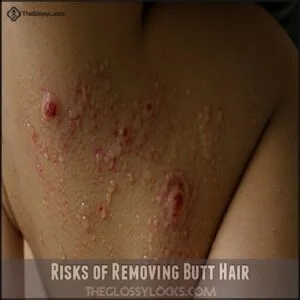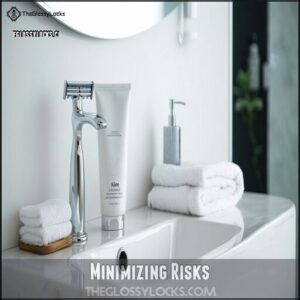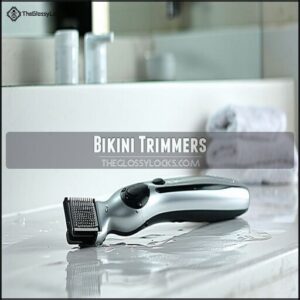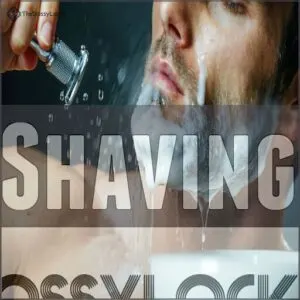This site is supported by our readers. We may earn a commission, at no cost to you, if you purchase through links.

Start by trimming long hairs with scissors or a bikini trimmer to avoid clogging your razor. Take a warm shower to soften the skin and open pores.
Use a clean, sharp razor and a gentle, unscented shaving cream or gel to avoid irritation. Shave in the direction of hair growth using short, light strokes.
Afterward, rinse the area with cool water and apply a soothing, fragrance-free moisturizer.
If shaving isn’t your style, there are other methods to explore—each with its own pros and cons.
Table Of Contents
- Key Takeaways
- Purpose of Butt Hair
- Usefulness of Butt Hair
- Temporary Removal Methods
- Shaving With Bikini Shaver
- Waxing With Professional
- Depilatory Creams Risks
- Laser Hair Removal and Electrolysis
- Risks of Removing Butt Hair
- Minimizing Risks
- Personal Preference and Seeking Advice
- Bikini Trimmers
- Shaving
- Waxing
- Frequently Asked Questions (FAQs)
- How do you shave a butt?
- Should I Shave my Butt hair?
- Why should you shave your butt?
- What should I do after shaving my butt hair?
- Should I use a sharp razor when Shave my Butt?
- How to remove Butt hair?
- How do I shave my nut hair?
- Is it normal for girls to have hair in their buttocks?
- How do you shave your gooch hair?
- What is the difference between shaving and waxing?
- Conclusion
Key Takeaways
- Clean the area thoroughly, trim long hairs, and use shaving cream made for sensitive skin to prep your skin effectively.
- Shave gently in the direction of hair growth with a sharp, clean razor to avoid nicks and irritation.
- After shaving, rinse with warm water, pat dry, and apply a soothing moisturizer to hydrate your skin.
- Consider alternatives like waxing or laser removal for longer-lasting results if shaving doesn’t suit you.
Purpose of Butt Hair
The humble butt hair serves several important evolutionary purposes you mightn’t realize.
Butt hair quietly works to reduce friction, block bacteria, and even served as an ancient tool of scent communication.
It acts as a friction reduction system between your cheeks during movement and creates a bacterial barrier protecting sensitive areas.
Historically, these hairs helped with fecal containment, trapping particles that could cause infection.
Some researchers suggest anal scent communication played a role in how our ancestors might attract mates.
While modern hygiene practices have reduced their necessity for comfort and cleanliness, these evolutionary reasons explain why we developed this hair in the first place.
Today, removing it’s entirely your personal choice.
Usefulness of Butt Hair
Before deciding whether to shave your butthole, it’s helpful to understand what butt hair actually does for your body. Contrary to what you might think, those strands serve several practical functions.
Butt hair provides four key benefits:
- Acts as a bacteria barrier, helping protect sensitive skin from infections
- Reduces friction between buttocks during movement, preventing chafing
- Helps with odor reduction by wicking away moisture
- Serves evolutionary purposes related to anal scent communication
While modern hygiene practices have reduced some needs for butt hair, understanding its functions can help you make an informed decision about removal methods that work best for your body. Some people choose temporary methods like shaving, but should be aware of potential razor burn risks.
Temporary Removal Methods
While butt hair serves natural functions, many people prefer removal for hygiene or aesthetic reasons.
Several temporary methods exist for butthole shaving and hair removal:
| Method | Duration | Pain Level | Cost | Ingrown Risk |
|---|---|---|---|---|
| Shaving | 1-3 days | Low | $ | High |
| Waxing | 3-4 weeks | High | $$ | Medium |
| Depilatory Creams | 3-5 days | None | $ | Low |
| Trimming | 1-2 weeks | None | $ | None |
| Epilators | 2-3 weeks | High | $$ | Medium |
Each technique requires specific razor types and aftercare to prevent razor burn and ingrown hairs. Proper shaving cream and moisturizing aftercare are essential regardless of your chosen method.
Shaving With Bikini Shaver
A bikini shaver offers precision for butthole shaving with less irritation than standard razors.
When selecting one for sensitive skin shaving, consider these features:
- Wet/dry shaving capability for use in or out of the shower
- Smaller shaver head design for maneuvering curved areas safely
- Corded vs cordless options (cordless provides better maneuverability)
- Hypoallergenic foil heads to minimize razor burn prevention
- Easy cleaning & maintenance features to prevent bacterial growth
Many bikini area grooming enthusiasts prefer these specialized tools because they trim hair close to the skin without direct blade contact.
Remember to sanitize your shaver before and after each use to keep your bikini shaver types in top condition.
Waxing With Professional
Professional waxing offers a longer-lasting solution for your backside grooming needs.
When visiting a professional, you’ll benefit from their expertise and proper technique, resulting in smoother results with minimal discomfort.
Costs typically range from $10-$30 per session, with treatments needed every 3-4 weeks as hair regrows.
The process involves applying hard wax to your sensitive areas, which is ideal since it’s gentler on skin.
Professional waxers work quickly and efficiently, causing only minor discomfort, and the results—smooth, hair-free skin for weeks—make professional waxing worth considering, despite the possibility of some redness afterward.
Depilatory Creams Risks
While depilatory creams might seem like an easy solution for butt hair removal, they pose significant risks that shouldn’t be overlooked, especially for sensitive skin areas like your butthole.
These hair removal creams contain powerful chemical exfoliants that break down hair proteins, but this same chemistry can cause:
- Chemical burns ranging from mild redness to serious skin damage if left on too long
- Allergic reactions including itching, swelling, and painful rashes that may last for days
- Infection risks when used on already irritated skin or microscopic cuts.
Always perform patch testing on a small area 24 hours before full application. Application errors are common – using too much product or leaving it on longer than directed dramatically increases the risk of adverse reactions.
Depilatories aren’t formulated for such sensitive regions, and the chemical compounds can easily irritate the delicate skin around your butthole. Remember that depilatories are generally safe for tattooed skin when used correctly. Consider gentler alternatives like careful shaving or professional waxing instead of exposing this sensitive area to harsh chemicals.
Laser Hair Removal and Electrolysis
While traditional methods offer temporary results, laser hair removal and electrolysis provide more permanent solutions for your sensitive areas.
Laser hair removal targets hair follicles with pulsating light beams, working best on dark hair against light skin. You’ll need multiple sessions (typically 4-8), with each treatment costing around $235.
Electrolysis uses electric current to permanently destroy individual follicles, making it effective for any hair color but potentially more painful. It’s more time-consuming as each follicle requires separate treatment.
Both methods offer lasting smoothness, though skin type substantially affects results. Consider treatment cost versus long-term benefits when choosing your path to permanent hair removal.
Risks of Removing Butt Hair
While laser treatments offer long-term results, it’s essential to understand what you’re risking when removing butt hair.
Removing hair in this sensitive area comes with several health concerns:
Beware of infection risks and irritation—removing delicate hair demands care to keep sensitive areas happy and smooth.
- Infection potential increases when bacteria enter tiny cuts or open follicles
- Skin irritation and razor bumps can make sitting uncomfortable for days
- Regrowth itch can be maddening in an area you can’t easily scratch in public
- Folliculitis risk rises as hair attempts to break through skin during regrowth
Shaving or waxing can also increase chafing between buttocks since hair naturally reduces friction.
Ingrown hairs are particularly common in this curved region due to the hair’s growth pattern.
The hair on your buttocks serves an evolutionary purpose, offering warmth and protection.
Minimizing Risks
The key to safe butt hair removal is preventing complications before they start.
Always wash with mild soap and warm water before shaving to minimize infection risk. Use a clean, sharp razor and short, gentle strokes in the direction of hair growth.
Apply shaving cream or gel designed for sensitive areas to create a protective barrier against razor burn and skin irritation. Never use harsh depilatory creams near your butthole as they can cause painful burns.
Tool sterilization is essential—dedicate a separate razor for this area only. For ingrown hair treatment, exfoliate gently between shaving sessions.
Personal Preference and Seeking Advice
The choice to remove butt hair is entirely yours – there’s no right or wrong answer.
When making your decision, consider both your comfort and what feels best for your body.
Here are three key considerations:
- Consult a dermatologist for personalized advice based on your skin type and sensitivity
- Research methods that match your pain tolerance and maintenance preferences
- Remember that partner opinions may influence but shouldn’t determine your grooming choices
Whether you’re embracing natural growth or seeking smoothness, your self-esteem matters most.
Consider skin type sensitivity when selecting your razor.
If you’re uncertain, start with temporary methods like shaving before trying more permanent solutions.
Bikini Trimmers
In the context of butt hair removal, bikini trimmers are a great option for precision and ease.
Look for small blades to navigate tight spots, like the butt cheeks, safely. Features like trimmer attachments can help tailor the tool to your needs—especially for the bikini area.
Corded vs cordless trimmers? Cordless gives flexibility, perfect for travel trimmers.
To prevent irritation, moisturize after trimming.
Always prioritize hygiene: clean the tool before and after use. Regular trimmer maintenance makes for safe and effective bikini area grooming every time.
Shaving
Shaving your butt requires careful technique to guarantee a smooth and safe result.
With the right tools and preparation, you can avoid irritation, bumps, and nicks while achieving a clean shave.
Preparing The Area
Start with proper anal hygiene by washing the area with warm water and soap, patting it dry.
Softening the skin and hair with a hot shower beforehand is essential for easier preparation.
Trim longer butt hair for easier shaving, keeping the trimming length manageable. Use a mirror for clear visibility to ensure you can see what you are doing.
Find a comfortable positioning, like propping one leg up, to guarantee safe and effective preparation.
Choosing The Right Razor
A good razor makes all the difference in butt hair shaving.
Pick one with multiple blades for smoothness or a single-blade razor for sensitive skin. A pivoting head helps glide over curves easily.
Look for a sturdy handle grip to avoid slips, and skip the cheap razors as they dull quickly.
Consider using a razor designed for sensitive skin areas. Always prioritize a high-quality razor for safe butt hair removal.
Applying Shaving Cream or Gel
Before you grab that razor, prep your skin with shaving cream or gel. Pick one made for sensitive skin—this helps prevent irritation and razor burn.
Look for cream ingredients like aloe or vitamin E for added moisture and protection. Avoid strongly scented creams, as they can sting.
Apply a generous, even layer to soften the hair and create a smooth barrier for the razor. If you don’t have shaving cream, opt for alternatives like coconut oil or conditioner for a seamless butt hair shaving experience.
Many prefer to use specialized creams available for this purpose, ensuring a smooth barrier and a comfortable shaving experience with added moisture.
Shaving Technique
Now that your shaving cream is applied, use gentle, steady strokes in the same direction as the hair growth.
Keep the skin taut to avoid nicks, and hold the razor at a slight angle for better control over curves. Apply light pressure to prevent irritation or razor burn.
Rinse the blade after every stroke to maintain sharpness and effectiveness. Razor maintenance is key—dull blades can cause cuts, so replace yours frequently.
With patience and precise shaving techniques, your butt hair removal will be smooth and safe.
Aftercare
Once you’ve finished shaving, proper aftercare keeps your skin smooth, healthy, and irritation-free. Treat the area with care since it’s sensitive after hair removal. Cleaning and moisturizing are your best friends here.
Wash gently with mild soap to prevent infection and remove residue. Then, moisturize to hydrate skin and soothe any irritation. Avoid using heavily scented products that can sting or cause a reaction.
Showering right after shaving helps wash away bacteria and sweat that might trigger razor bumps. Loose, breathable clothing is another must—tight fabrics can rub against freshly shaved skin and cause discomfort.
- Wash with mild soap to prevent infection.
- Moisturize to hydrate skin and soothe irritation.
- Avoid tight clothing to reduce friction and discomfort.
- Exfoliate regularly to prevent ingrown hairs.
- Check the area for signs of razor bumps and irritation.
Waxing
Waxing is a longer-lasting option that removes hair at the root, leaving you with smooth results for weeks.
It’s important to prepare properly and choose the right type of wax to avoid irritation or discomfort, which makes proper preparation crucial for a successful waxing experience.
Preparing for Waxing
Before waxing, proper prep makes all the difference for smooth results and less discomfort. Start by cleaning the area with an antiseptic solution to remove bacteria and dirt, then let it air dry.
This creates a clean surface, lowering infection risks during butt hair removal. If your hair length exceeds 0.25 inches, trim it for easier waxing.
Exfoliation is another must. Do it a day or two before waxing to gently remove dead skin. This prevents clogged follicles, especially on sensitive skin.
When it’s time, select a wax type suited for your needs; cold wax strips can be gentler. Managing pain? Try applying a numbing cream or breathing deeply to relax. These simple steps keep your waxing experience manageable.
Choosing The Right Wax
Picking the right wax matters for a safe waxing experience.
Hard wax works best for sensitive skin and smaller areas, like butt hair removal. Soft wax suits larger sections but can irritate delicate spots. Sugar wax is gentle but tricky to master.
Many prefer to use quality hard wax for hair removal.
Keep these in mind:
- Wax Types
- Temperature Control
- Hair Length
- Skin Sensitivity
- Pain Management
Applying Wax
Once you’ve chosen the perfect wax, start by testing the wax temperature on your wrist to avoid burns.
Verify your hair length is about a quarter-inch for proper grip. Apply a thin layer of wax in the direction of hair growth, working in small sections for better precision.
Use a strip technique by firmly pressing the cloth or paper strip onto the wax. Keep the area taut to maximize effectiveness.
Follow the product’s guidelines for safe and effective butt hair removal.
Removing Wax
After pulling off the wax strips, it’s time to clean up any wax residue.
Gently use baby oil or witch hazel to remove leftover bits, especially if you have sensitive skin. Rinse the area with warm water to reduce bacteria and soothe open pores.
For pain management, apply aloe vera or a light moisturizer. Exfoliating a day later helps with ingrown prevention.
Whether you’re exploring waxing alternatives or sticking to a clean shave, proper post-wax care guarantees smooth, irritation-free results.
Frequently Asked Questions (FAQs)
How do you shave a butt?
Imagine you’re prepping for a delicate mission.
Clean the area first with warm water, trim long hair with a trimmer, apply shaving cream, hold skin taut, and shave gently with short strokes.
Stay patient, stay safe.
Should I Shave my Butt hair?
Shaving your butt hair is a personal choice.
It can feel cleaner, reduce sweat, and improve comfort, but it’s high-maintenance.
Consider pros, cons, and alternatives like trimming or waxing before deciding what’s best for you.
Why should you shave your butt?
Shaving your butt can reduce sweat, odor, and itchiness while improving comfort and appearance.
It’s a personal choice that helps some feel cleaner and more confident, especially during activities like workouts or wearing tight clothing.
What should I do after shaving my butt hair?
After shaving, rinse with warm water and pat dry.
Apply a gentle moisturizer, like aloe vera, to soothe the skin.
Avoid tight clothing, exfoliate gently after a day, and monitor for irritation or ingrown hairs.
Should I use a sharp razor when Shave my Butt?
You absolutely need a sharp razor, no exceptions.
A dull blade tugs the skin, causes irritation, and increases the risk of nicks.
Keep it fresh and clean to guarantee a smooth, safe experience every time.
How to remove Butt hair?
To remove butt hair, wash the area, trim longer hair first, and shave using a sharp razor with shaving cream.
Alternatively, try waxing, laser hair removal, or professional treatments for longer-lasting results.
How do I shave my nut hair?
Nurture neatness with a trusty trimmer—start by shortening long hairs to avoid razor clogs.
Hold skin taut, use shaving cream, and shave gently in the direction of growth.
Rinse, moisturize, and avoid tight clothes afterward.
Is it normal for girls to have hair in their buttocks?
Yes, it’s completely normal!
Body hair, including in the buttocks area, naturally grows regardless of gender.
It’s just part of being human, and everyone’s hair thickness, color, and placement vary widely, which makes being human a unique experience.
How do you shave your gooch hair?
Cutting corners" here is a no-go—start clean with warm water and soap.
Trim long hair first, use shaving cream, and a sharp razor.
Shave gently, directionally, with short strokes.
Rinse, dry, and moisturize after.
What is the difference between shaving and waxing?
Shaving cuts hair at the surface, offering quick results but regrowth in days and risks like irritation.
Waxing pulls hair from the roots, lasting weeks but causing discomfort during removal.
Both need proper care afterward, and understanding these methods is key to managing regrowth.
Conclusion
Taking care of your grooming routine, including learning how to shave your butthole, can keep you feeling clean and confident.
By preparing your skin, choosing the right tools, and using proper technique, you’ll reduce irritation and achieve smooth results.
If shaving isn’t for you, consider other methods like waxing, creams, or laser removal.
Always prioritize safety and comfort, and don’t rush the process.
Ultimately, your personal preference and body care needs should guide your decision.














